|
|
|
HOT CLUB OF SAN FRANCISCO
 Cool
Yule Cool
Yule
Azica
Records
By Tom
Ineck
Ole Saint
Nick hops on the gypsy caravan for a swinging “Cool Yule” celebration of
the season by the Hot Club of San Francisco.
Paul
“Pazzo” Mehling leads the ensemble through a collection of mostly
familiar holiday tunes, utilizing various configurations of the quintet
and additional guest artists, creating a loose, party-like atmosphere of
friends and musical colleagues. The core group consists of Mehling on
guitars and vocals, Clint Baker on bass and trumpet, Evan “Zeppo” Price
on violins, Jeff Magidson on rhythm guitar, bass and vocals, and Jason
“Jubilation” Vanderford on rhythm guitar.
Mehling
takes the lead vocal on Steve Allen’s opening title track, once a hip
hit for Louis Armstrong. “Don Rodolfo” is a moody, Spanish-tinged take
on that famous red-nosed reindeer, as arranged by Mehling. “Carol of the
Bells” is combined with Vince Guaraldi’s “Skating” for a delightfully
danceable rendition in waltz time, arranged by Price. The rhythm guitars
keep the chunka-chunka beat going strong as the lead guitar and fiddle
mix it up in tandem.
For the
touchingly sentimental “I’ll Be Home For Christmas,” the quintet is
accompanied by the so-called Cool Yule Philharmonic, a string quartet
with Evan and Deborah Tien Price, violins; Marcel Gemperli, violas; and
Eric Gaenslen, celli. A hip addition to any Christmas collection, “Baby,
It’s Cold Outside” gets the full treatment with romantic banter by
Isabelle Fontaine and Jeff Magidson. “Djingle Bells” is an obvious tip
of the holiday hat to Django Reinhardt, the patron saint of Hot Clubs
everywhere.
Duke
Ellington and Billy Strayhorn had fun with Tchaikovsky’s “Nutcracker
Suite,” reimagining one movement as “Sugar Rum Cherry.” The Hot Club
retains Duke’s bluesy take with guitar, bass, electric octave violin,
trumpet and finger snaps. Members of the Cool Yule Philharmonic rejoin
the quintet for a loving, respectful version of the Appalachian folk
melody “I Wonder as I Wander.”
“March of
the Toys” begins in stately march fashion before morphing into a joyous
gypsy ramble when the slap-bass picks up the tempo and Mehling and Price
go at it with gusto. The band is pared down to Le Jazz Hot Trio for a
reverent ballad take on “The Christmas Song.” Mehling insinuates a
tasteful lead on baritone guitar, with Magidson on rhythm guitar and
Baker on bass.
The
celebrative mood returns with “Santa Claus Is Coming to Town,” as
Mehling sings and swings. As a closer for the year, “Auld Lang Syne” is
always a bittersweet mix of sadness and joy. As a swinging closer for
this session, the Hot Club exudes hopeful anticipation and good humor,
referencing Reinhardt and quoting “O Tannenbaum.” After a long pause,
the band returns briefly with a rapidly accelerating statement from “We
Wish You a Merry Christmas.”
top |
|
|
|
VARIOUS ARTISTS
 Jazzy
Brass for the Holidays Jazzy
Brass for the Holidays
DB
Records
By Tom
Ineck
Trumpeter
Eddie Allen is the leader on “Jazzy Brass for the Holidays,” having
arranged all 14 tunes, but he keeps a low profile along with the others,
who include Cecil Bridgewater on trumpet, W. Marshall Sealy on French
horn, Clark Gayton on trombone, Kenny Davis on bass and Carl Allen on
drums and glockenspiel.
Together,
they form a formidable ensemble, ideal for the brass chorale treatment
of traditional Christmas favorites such as “It Came Upon the Midnight
Clear,” the opener. Sealy and Gayton create a warm glow in the lower
registers as Allen and Bridgewater soar overhead on their brighter,
brassier instruments.
“Go Tell it
On the Mountain” draws from the black spiritual tradition and is aptly
soulful in its swinging mid-tempo, but Sealy ends his solo with a
tentative resolution. Gayton delivers a strong trombone lead on “God
Rest Ye Merry, Gentlemen,” and the trumpets are triumphant in the
swaggering manner of Wynton Marsalis on “Hark! The Herald Angels Sing.”
A similar bluesy is apparent on “Away in a Manger.”
“What Child
Is This?” features a flawless trumpet statement by Bridgewater, clearly
the standout soloist of the entire session.
While the
overall theme is religious, there are also four secular favorites.
“Frosty the Snowman” and “Jingle Bells” (reversed in sequence on the CD
cover) are given faithful treatments, and “Deck the Halls” is another
highlight, though clocking in at just 1:36 minutes. On the other hand,
“Let It Snow! Let It Snow! Let It Snow” allows Bridgewater and Gayton
ample space for improvisation.
Brassy
colors abound on “We Three Kings,” with a nice muted trumpet solo by
Eddie Allen and spirited drum playing by Carl Allen. “Good King
Wenceslas/Cool King Wenceslas” rocks with a back beat, while “Little
Drummer Boy” marches to a different drummer with a Mardi Gras rhythm
straight from the streets of New Orleans. “O Holy Night” closes the CD
with a stately tone set by Sealy on French horn and carried through by
Bridgewater on trumpet, Gayton on trombone and Allen on trumpet.
Despite its
low-budget packaging, the absence of liner notes and occasional fluffed
notes, “Jazzy Brass for the Holidays” is a decent addition to the
holiday jazz genre.
top |
|
|
|
KENNY BURRELL
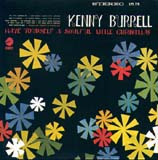 Have
Yourself a Soulful Little Christmas Have
Yourself a Soulful Little Christmas
Verve
Records
By Tom
Ineck
Guitarist
Kenny Burrell’s “Have Yourself a Soulful Little Christmas” is one of
those rare jazz holiday recordings that stands the test of time while
avoiding cliché. Recorded in October 1966 and originally released on the
Chicago-based Cadet label, it remains as fresh and moving as it was more
than 40 years ago, thanks in large part to a 2003 digital transfer.
Burrell’s
Wes Montgomery-inspired guitar is the star of the show here, accompanied
by an orchestra of unidentified musicians conducted by Richard Evans. It
all begins with a stunning version of “The Little Drummer Boy,” which
was still a popular novelty tune in 1966, having become a huge hit just
a few years earlier. Burrell’s playing builds in bluesy intensity as a
bolero, the horns providing powerful punctuation behind his soulful
outpouring of notes.
“Have
Yourself a Merry Little Christmas,” on the other hand, adheres to a more
traditional ballad take, with lush strings backing Burrell’s tender and
tasteful sentimentality. Burrell begins similarly on “My Favorite
Things” until the tempo accelerates and the horns enter with brio. He
then matches their spirited attack note for note, eventually breaking
away for a driving solo statement.
Perhaps the
most moving track is the lullaby, “Away in a Manger,” with subtle
strings accompanying Burrell’s acoustic-sounding chording. “Mary’s
Little Boy Chile’” goes Caribbean, complete with added percussion.
Teamed with a piano trio, also nameless, Burrell’s playing is simplicity
incarnate on “White Christmas.” The melody is largely stated with chords
enhanced with brief single-note runs.
“God Rest
Ye Merry, Gentlemen” is performed as a gentle jazz waltz, with Burrell’s
fret-board octaves set off by some very impressive drumming and backed
by a string section. Woodwinds and vibes set the stage for an absolutely
gorgeous version of “The Christmas Song,” which swings uptempo briefly
before returning to a ballad. The traditional gospel tune “Children, Go
Where I Send Thee” gets the full soul treatment with Hammond B-3,
shouting horns, rocking drums and tambourine as Burrell soars with
soulful inspiration.
Burrell’s
guitar is paired with piano on a loping “Silent Night,” giving it a
country-gospel feel that would have been perfect for Ray Charles. “The
Twelve Days of Christmas” swings on the strength of a walking bass,
lively drumming and Burrell’s brilliant fretwork. The finale is “Merry
Christmas, Baby,” leaving the listener with no delusions that this
recording is anything but a very soulful holiday celebration.
For those
of us with failing eyesight, the original liner notes are reproduced in
large print on a separate insert.
top |
|
|
|
SCOTT HAMILTON with STRINGS
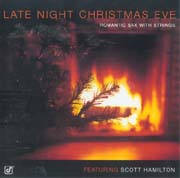 Late
Night Christmas Eve: Romantic Sax with Strings Late
Night Christmas Eve: Romantic Sax with Strings
Concord
Records
By Tom
Ineck
Since its original release in 1997 under the title
"Christmas Love Song," this gorgeous, hour-long Yuletide tribute
by tenor saxophonist Scott Hamilton has never been far from my sound
system during the holiday season. It is especially recommended for
late-night listening.
Hamilton’s
lush, breathy tone is custom-made for ballad treatments of such classics
as “I’ll Be Home for Christmas,” “Have Yourself a Merry Little
Christmas,” “Christmas Waltz,” “Greensleeves (What Child Is This?),”
“White Christmas,” and Johnny Mandel's lesser-known "Christmas Love
Song." When given the sweeping backdrop of the London String Ensemble,
arranged and conducted by jazz pianist Alan Broadbent, the sound is
simply sublime.
Woodwinds
and French horn are added on several tunes, including “The Christmas
Song,” “Little Drummer Boy,” “Winter Wonderland,” and “Bell Carol
Blues,” a spirited take on “Carol of the Bells.”
Broadbent,
bassist Dave Green, guitarist Dave Cliff and drummer Allan Ganley also
figure prominently, accompanying Hamilton with grace and aplomb. Their
playing is subtle but noteworthy on mid-tempo numbers like “Little
Drummer Boy,” “Winter Wonderland,” “Santa Claus is Coming to Town,” and
“Bell Carol Blues,” the sole swinger in this collection.
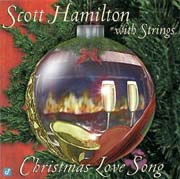 As
always, Hamilton’s playing is remarkable for its restraint and good
taste. His burry tone, well-paced phrasing and gentle improvisations are
perfect for the ballad treatments that predominate here. As
always, Hamilton’s playing is remarkable for its restraint and good
taste. His burry tone, well-paced phrasing and gentle improvisations are
perfect for the ballad treatments that predominate here.
For the
record,
"Late Night Christmas Eve: Romantic Sax with Strings” is a repackaged
and re-released 2000 version of
1997's "Christmas Love Song."
Presumably, it was re-issued simply to take advantage of the new, more
provocative title. No matter what you call it, it remains good holiday
listening.
top |
|
|
|
VARIOUS ARTISTS
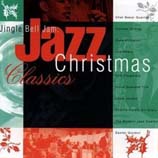 Jingle
Bell Jam: Jazz Christmas Classics Jingle
Bell Jam: Jazz Christmas Classics
Rhino
Records
By Tom
Ineck
Fifteen
years after its initial release in 1994, “Jingle Bell Jam” remains one
of the best Christmas jazz anthologies ever produced. Given the
involvement of Rhino Records—the most ambitious cross-licensing label
out there—that’s no surprise. The result is a pretty definitive,
18-track single-disc collection of Yuletide jazz.
The
recording dates range from 1948 to 1990—with most tracks coming from the
1960s—but the sequencing was dictated by listening pleasure rather than
strict chronology. From pianist Duke Pearson’s 1969 version of “Sleigh
Ride,” we move to Vince Guaraldi’s iconic “Christmas Time Is Here” from
1967, and then to trumpeter Chet Baker’s rollicking bop take on “Winter
Wonderland,” recorded in 1953.
From 1990
comes Carmen McRae’s “The Christmas Song,” with Clifford Jordan on tenor
sax and Shirley Horn at the piano. That leads to “Deck the Halls,” a
1964 recording by the Bobby Timmons Trio, a medley of seasonal tunes
recorded by The Swingle Singers in 1968, Duke Ellington’s 1962 big band
rumble on “Jingle Bells,” and Lou Rawls crooning baritone on “Have
Yourself a Merry Little Christmas,” from 1967.
Pianist
David Benoit updated “Carol of the Bells,” recorded in 1983, leads us
back to “Good Morning Blues,” a track from Ella Fitzgerald’s 1960
Christmas collection, followed by Booker T & the MGs and their soulful
rendition of “Merry Christmas, Baby” from 1966, Louis Jordan and the
band with a Teddy Edwards original “Santa Claus, Santa Claus,” recorded
in 1968, and alto saxophonist Charlie Parker wailing on “White
Christmas,” a rare recording taped during a live performance on
Christmas Day 1948 at The Royal Roost in New York City.
We leap
from the ‘40s to the ‘90s for “Boogie Woogie Santa Claus,” a 1990
recording by the a cappella group Inner Voices, then to the Modern Jazz
Quartet for their stately reading of “England’s Carol #1,” recorded
during a live performance in Lenox. Mass., in 1956, and from there to a
1970 recording of “The Christmas Song” by tenor saxophonist Dexter
Gordon, accompanied by pianist Tommy Flanagan, bassist Larry Ridley and
drummer Alan Dawson.
With
Christmas given its due, the last two tracks look ahead to the New Year.
Saxophonist King Curtis (with Duane Allman on guitar) offers a
soul-drenched 1968 rendition of “What Are You Doing New Year’s Eve,” and
the recording is topped off with the Roy Kral-Jackie Cain Sextet doing
“Auld Lang Syne,” from 1949.
With liner
notes by Will Friedwald, complete recording and personnel data and a
re-mastering job that minimizes the recording disparities of the
original tapes, “Jingle Bell Jam: Jazz Christmas Classics” is, indeed, a
Christmas gift that keeps on giving.
top |
|
|
|
JOHN SCOFIELD
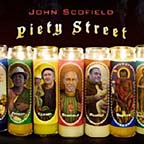 Piety
Street Piety
Street
EmArcy
Records
By Tom
Ineck
At least
since he hired New Orleans drummer Johnny Vidacovich for his 1989
recording “Flat Out,” guitarist John Scofield has frequently displayed a
penchant for the sounds and rhythms of the Crescent City. That
inclination arrives full-blown from the first notes of his latest
release, “Piety Street.”
This time,
the New Orleans City vibe is informed by the traditions of gospel music,
but you don’t have to be a born-again Christian to enjoy the soulful
nature of this enterprise. Recorded at Piety Street Studios in the Big
Easy, it veritably reeks of that city’s long musical tradition, steeped
as it is in elements of the blues, jazz, soul, country and the island
rhythms of the Caribbean.
Like 2005’s
“That’s What I Say: John Scofield Plays the Music of Ray Charles,” the
guitarist has chosen to augment his distinctive fretwork with guest
musicians and singers befitting the occasion. Most notable is the
significant presence of Jon Cleary on vocals, piano and organ. Cleary’s
rough-hewn voice perfectly conveys the yearning and redemptive spirit of
“That’s Enough,” “Motherless Child,” “Just a Little While to Stay Here”
and “Walk With Me.”
Also making
important contributions to the overall sound are George Porter Jr. on
bass, Ricky Fataar on drums, John Boutte on vocals and Shannon Powell on
tambourine and drums. For full gospel-choir effect, everyone joins in
backing vocals and hand-clapping as The Hard Regulators.
Most of the
13 tracks are drawn from the annals of the gospel tradition, but
Scofield adds to that tradition with his compositions “It’s a Big Army”
and “But I Like the Message.” The former is a rousing gospel march with
guitar and piano playing the roles of call-and-response preacher and
congregation. “Message” is a soulful instrumental strut.
Among the
familiar classics of the genre are “His Eye is On the Sparrow,” Thomas
Dorsey’s songs “The Old Ship of Zion” and “Never Turn Back,” Rev. James
Cleveland’s “Something’s Got a Hold on Me” and the traditional “I’ll Fly
Away.” One of the most moving interpretations is Scofield’s version of
“The Angel of Death,” a country classic by Hank Williams. At nearly
seven minutes, it is the emotional centerpiece of the project, with an
absolutely hair-raising vocal by Cleary.
At any
tempo, Scofield digs into these numbers with a passion. Utilizing the
wah-wah and his usual bag of sonic tricks, he wrenches every morsel of
the blues from them, squeezing off notes and bending strings as if
vocalizing the lyrics—and lyrical improvisations—with his guitar.
top |
|
|
|
MOODY
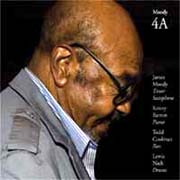 4A 4A
IPO
Recordings
By Tom
Ineck
In its hip
shorthand, “4A” speaks volumes, and the artist identified simply as
Moody needs no introduction. It is the first release of a stellar James
Moody quartet captured in two recording sessions on consecutive days.
Moody, age
83 at the time of this July 2008 recording, remains in top form, his
phenomenal breath control, keen harmonic sense, melodic invention and
sly wit intact. And he is more than ably accompanied by pianist Kenny
Barron, bassist Todd Coolman and drummer Lewis Nash.
Nash
unexpectedly kicks off “Secret Love” at a medium march tempo that
indicates much fun will be had by all. Moody’s own solo statements brim
with humor, tossing off quotes from “On the Trail” and “Bebop” while
keeping the mood relaxed. Barron and Coolman contribute brief by
sterling solos before Nash returns with military precision.
Barron’s
classic “Voyage,” a favorite of Stan Getz, Phil Woods and other reed
men, inspires the best from all. The tune’s odd chord changes invite
harmonic experimentation. “Round Midnight” gets yet another reverent
ballad reading, with everyone fully engaged in its overt romanticism.
The rhythm section swings uptempo with assurance on “Without a Song,”
allowing Moody to stretch his bop chops.
Another
familiar favorite, “Stella By Starlight,” gets a sprightly Latin
treatment. “East of the Sun” is a gorgeous duet between Moody and
Barron, perhaps the highlight of the entire CD. It reminds this listener
of “People Time,” a collection of live, profoundly beautiful duets
between Barron and Getz shortly before the saxophonist’s death in 1991.
Moody pays
his respects to another saxophonist with “Stablemates,” a Benny Golson
standard taken uptempo. The quartet offers its farewell in waltz time
with “Bye Bye Blackbird,” on which Moody turns up the heat in a blazing
romp, both Barron and Coolman deliver brilliant solos and Moody returns
for a coda.
Needless to
say, we await “4B” with much anticipation.
top |
|
|
|
FRED SIMON
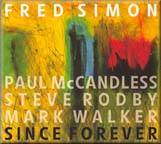 Since
Forever Since
Forever
Naim
Jazz
By Tom
Ineck
Pianist
Fred Simon’s keyboard style has been unfairly labeled “fusion” or “new
age,” with all of the negative connotations those narrow confines imply.
His lyrical touch and keen melodic sense transcend the merely
meditative, and his original tunes haunt the memory without ever seeming
trite.
Simon’s
latest release, “Since Forever” has been haunting me for several weeks
now. I find myself returning to it day after day, always discovering
some subtle rhythmic change or some exquisite harmonic phrase that I had
missed the last time. Conversely, his tunes often sound timeless on
first hearing. That is a true composer’s natural gift and a listener’s
delight.
Over a
period of 30 years, Simon’s musical associations have ranged from
guitarists Larry Coryell, Ralph Towner and Fareed Haque to violinist
Jerry Goodman, bassists Steve Rodby and Michael Manring and reed
virtuoso Paul McCandless. For his latest, he again taps some of his
longtime cohorts, creating a seamlessly cohesive quartet that also
features McCandless, Rodby and drummer Mark Walker.
“Since
Forever” has an elegiac quality. In fact, three of the 12 tracks are
memorials. Yet, the recording eschews cheap, maudlin sentimentality for
a more profound, sadness-tinged celebration of life. The title track, a
gorgeous anthem for folksinger and social activist Pete Seeger, is a
well-earned tribute to a living American hero.
Simon and
McCandless work so well in unison, it’s hard to tell them apart
sometimes. On “No War Nowhere,” with McCandless on soprano sax, they
simultaneously play the joyous melody, and then go their separate ways
for solo statements. Rodby and Walker are perfectly in synch with the
tune’s shifting time signature.
Simon pays
homage to his late sister with “Even in the Evening,” on which
McCandless weaves intricate English horn lines against dark piano chords,
sustained by a bass ostinato and flashing cymbals. “I Know You Know” is
a tantalizing jazz waltz with an irresistible melody that sends
McCandless soaring on soprano.
The sole
non-original tune is “In a Silent Way,” included as a memorial to its
composer, Joe Zawinul. It is a hard to imagine a more touching tribute.
“More Often Than Not” is a memorial to friend Patti McKenny, a Chicago
playwright who died of a heart ailment in June 2008, at age 57. “Simple
Psalm” is a new version of a tune first heard on a Windham Hill
recording many years ago. Walker and Rodby are allowed some very free
playing as Simon and McCandless, on oboe, adhere to the simple folk
melody.
“Same
Difference” is a piano-soprano sax duet with yet another memorable, haunting
melody. Rodby is featured on “Ways of Seeing,” exploring the bass’
harmonic range from top to bottom in counterpoint to the piano, oboe and
soprano sax. “What’s the Magic Word?” is a delightfully uptempo ramble.
Simon infuses a Middle Eastern sound on “Song of the Sea,” with
McCandless adding to the mood on the duduk, English horn and soprano
sax.
At nearly
64 minutes, “Since Forever” is a generous offering from underappreciated
composer and pianist Fred Simon.
top |
|
|
|
QUARTET SAN FRANCISCO
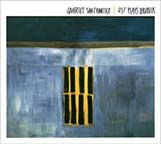 QSF
Plays Brubeck QSF
Plays Brubeck
ViolinJazz Recordings
By Tom
Ineck
A classical
string quartet playing the music of Dave Brubeck? Sure, why not? It’s no
stranger than the Kronos Quartet paying tribute to the music of
Thelonious Monk and Bill
Evans on classic recordings that iconoclastic
foursome made more than 20 years ago. In fact, given Brubeck’s own
classical influences and proclivities, it makes perfect sense.
Quartet San
Francisco’s approach is adventurous, while remaining true to the
original tunefulness and wit of Brubeck’s familiar melodies. It is
immediately apparent that violinists Jeremy Cohen and Alisa Rose,
violist Keith Lawrence and cellist Michelle Djokic bring the requisite
technique and sense of humor to the project, injecting flights of fancy
throughout the opener, the lilting “Three to Get Ready.”
“Strange
Meadowlark,” the longest track at nearly eight minutes, yearns with the
somber beauty and romanticism of its title, but the QSF shows its
willingness to improvise with pizzicato passages, unconventional
counterpoint and imaginative harmonies. A sawing rhythmic groove kicks
off “The Golden Horn” and eventually shifts it into jazzy overdrive. In
a delightful arrangement by Brubeck’s son, Matt, the quartet teases with
Ellington quotes—“Don’t Get Around Much Anymore,” “I’ve Got It Bad (And
That Ain’t Good”)—before launching into “The Duke.”
Of course,
no Brubeck tribute would be complete without a rendition of “Take Five,”
which was actually written by alto saxophonist Paul Desmond during his
halcyon days with the quartet. While the others keep the rhythmic riff
pulsing, a violin soars high above before returning the theme to the
cellist. A brisk waltz tempo enters more than a minute into “Kathy’s
Waltz,” keeping the listener on his proverbial toes in three-quarter
anticipation.
The
centerpiece here is the virtuosic “Blue Rondo a La Turk,” with its
driving tempo, interweaving lines, alternating themes and soulful solo
improvisations as the QSF morphs into a blues band. The more obscure
“Bluette” is a gorgeous ensemble piece of delicate beauty and grace.
Another highlight is the brief foray into hillbilly jazz with “Unsquare
Dance.” Ragtime also gets its due with a spirited reading of the Brubeck
classic “It’s a Raggy Waltz.”
“Forty
Days” is another workout for the entire ensemble, with beautiful
harmonies and a haunting melody line. The CD ends somewhat oddly with a
lovely take on the Christmas chestnut “What Child Is This?”
Brubeck
himself gives this project his stamp of approval. “I got a kick out of
hearing these talented musicians interpret my music in such an inventive
way,” he writes inside the CD jacket. “It’s an honor for a composer to
have his music re-visited by a group such as Quartet San Francisco.” We
concur.
top |
|
|
|
KURT
ELLING
Dedicated To You: Kurt Elling Sings the Music of Coltrane and Hartman
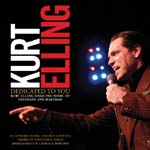 Concord
Jazz Concord
Jazz
By Tom
Ineck
Much as
Karrin Allyson in recent years paid homage to Coltrane’s classic
“Ballads” release of 1962, singer Kurt Elling here turns his attention
to the timeless “John Coltrane and Johnny Hartman” LP of the following
year. To the top-notch rhythm section of pianist Laurence Hobgood,
bassist Clark Sommers and drummer Ulysses Owens, he adds tenor saxophone
great Ernie Watts and a string quartet and performs it for a live
audience at Lincoln Center in New York. The result is magical.
First
commissioned by the 2006 Chicago Jazz Festival for the commemoration of
Coltrane’s 80th birthday, Elling’s tribute is a brilliantly
paced program that pays its respects to the iconic recording while
adding something of its own to the story.
The
original recording lasted only 31 minutes in six tracks, so Elling and
arranger-pianist Hobgood added several other standards often associated
with Coltrane, most notably the opening “All or Nothing at All,” on
which Watts demonstrates his own original sound, never attempting to
mimic the master.
Elling’s
penchant for dramatic spoken interludes is well served as he sets the
scene of the March 1963 Coltrane-Hartman session with “A Poetic Jazz
Memory,” a historical narrative—with lush string accompaniment—that
increases our anticipation for what follows. It documents the fact that
although the two principals had met only the week before, their combined
masterpiece would be completed in just three hours, with no charts and
no rehearsal. Most tunes were recorded in one take.
The story
introduces a medley that begins with a rambunctious rendition of the
song “Dedicated to You,” featuring an outstanding piano solo by Hobgood.
Pizzicato strings embellish the tune with bright percussive flashes.
Watts returns for a lush instrumental version of “What’s New,” another
addition to the original program and a perfect segue into Billy
Strayhorn’s mournful “Lush Life.” Elling and Hobgood state the opening
verse before the rest of the band enters. The singer is especially
impressive as he soars into a beautifully controlled falsetto. The
medley ends with Watts creating an appropriately nocturnal mood on
“Autumn Serenade.”
“Say it
(Over and Over Again)” is another great vehicle for Watts’ controlled
power and improvisational skills as he caresses the romantic ballad with
an extended solo, setting the stage for Elling’s own vocal magic. The
rhythm section proclaims “They Say It’s Wonderful” with swaggering
confidence, and Hobgood delivers another stunning solo.
A second
medley begins with “My One and Only Love,” as Elling’s voice pairs off
with the string quartet in a call-and-response dialogue. It segues
nicely into a smoothly swaying “Nancy with the Laughing Face.” After
thanks to all, Elling and company finish with one of the most memorable
songs from the Coltrane-Hartman recording, “You Are Too Beautiful.”
By nature,
Elling’s voice is pitched higher than Hartman’s smoky bass-baritone, but
he is capable of sliding easily through several octaves. It may not have
seemed a likely project, but it retrospect it works beautifully. Elling
has scored another triumph.
top |
|
|
|
KENDRA SHANK QUARTET
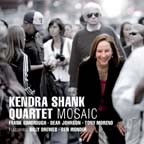 Mosaic Mosaic
Challenge Records
By Tom
Ineck
“Mosaic” is
the latest leg in Kendra Shank’s spiritual journey through music. Unlike
her previous release, 2007’s “A Spirit Free”—a very focused, ambitious
and loving homage to Abbey Lincoln—she returns to a more varied menu of
jazz standards, originals and even a pop tune by Carole King.
As always,
the constant here is Shank’s outstanding ensemble, longtime bandmates
Frank Kimbrough on piano, Dean Johnson on bass and Tony Moreno on drums,
plus the versatile reed playing of Billy Drewes and the guitar shadings
of Ben Monder. Shank’s fidelity to this same lineup has paid off in an
uncanny compatibility and flawless interplay, despite (of because of)
its penchant for risk-taking. For Shank’s take on the new release, see
the interview I conducted with her elsewhere in this newsletter.
It’s hard
to imagine a more compelling opener than King’s “So Far Away,” a
touching interpretation of the pop classic raised to new heights by the
sensitive playing of all, including an absolutely gorgeous clarinet solo
by Drewes. Shank’s ability to plumb the emotional depth of such a
timeworn tune is only one of her many strengths. She fearlessly
improvises on Cedar Walton’s “Mosaic,” here titled “Life’s Mosaic,” with
lyrics by John and Paula Hackett. Drewes turns in a sinuous solo,
followed by Monder’s own soaring solo excursion. Moreno also leads the
rhythm section on a sonic adventure.
Rather than
the conventional approach to the standard “Blue Skies,” Shank and
company slowly enter the melody from an improvised introduction the
singer calls “Reflections in Blue.” Again, the technique allows
listeners to re-imagine the familiar Irving Berlin song. Similarly, the
old warhorse “Smile,” with music by Charlie Chaplin, is given a new
lease on life by marrying it to the more upbeat “Laughing at Life.”
Johnny
Mandel’s lovely ballad “The Shining Sea,” with lyrics by Peggy Lee, gets
a reverent, but fully engaging treatment, with Kimbrough accompanying
with lush chords. In another medley, the mystic verse of Rumi entitled
“Water from the Spring” is used to draw new meaning from another
standard, Victor Young’s “Beautiful Love.” Beginning and ending with a
rhythmically free section, the music seems to ebb and flow as naturally
as the spring water of the title.
One of the
most beautiful new compositions on the CD is the ballad “For Duke,” with
music by Kimbrough and poetic lyrics by the pianist’s wife,
Maryanne de Prophetis. Shank handles the tune
with great sensitivity and respect, and it is made even more profound by
an extended piano solo. Shank freely expresses all the joy and surrender
inherent in Cole Porter’s “All of You,” and the band responds with equal
delight, especially in Johnson’s whimsical bass solo.
“Time Remembered,” one of Bill Evans’ most
evocative ballads, gets an inspired reading by all. Shank caresses the
lyric by P. Lewis, Kimbrough and Drewes (on clarinet) engage in an
inspired musical dialogue, and Monder’s signature guitar tone helps to
create a dream-like mood. Kirk Nurock composed the last two tracks, the
mid-tempo waltz “I’m Movin’ On,” with lyrics by Judy Niemack, and “I’ll
Meet You There,” with lyrics that Nurock adapted from Rumi.
With “Mosaic,” Shank and her compatriots have
created another sterling example of the jazz artist’s craft at its most
technically accomplished and most emotionally revealing.
top |
|
|
|
THE BENNIE MAUPIN QUARTET
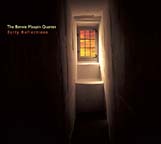 Early
Reflections Early
Reflections
Cryptogramophone Records
By Tom
Ineck
With “Early
Reflections,” reed virtuoso Bennie Maupin continues a comeback as leader
that began with 2006’s “Penumbra,” also on the Cryptogramophone label.
This time, Maupin takes his sublime artistry in a new, evocative
direction.
Indeed,
Maupin takes it all the way to Warsaw, Poland, where he assembled a
quartet that also features pianist Michal Tokaj, bassist Michal Baranski
and drummer Lukasz Zyta, with wordless vocalizing of Hania
Chowaniec-Rybka gracing two tracks. The group toured together for two
years before retiring to the studio, and the rapport is evident.
A
seamlessly organic whole of nearly 80 minutes duration, the music
simultaneously evokes the mystery of Poland’s natural beauty and the
melancholy spirit of its people. With only a few exceptions, the tempos
are largely downbeat, but the playing by Maupin on bass clarinet, tenor
and soprano saxes and alto flute seems to rise out of the ether in
hopeful aspiration. With backgrounds in classical music as well as jazz
improvisation, the accompanying trio of players is unfailingly
sympathetic.
The mood is
intimate and introspective. On the lovely “Escondido,” Maupin, on bass
clarinet, pairs off with Baranski in a warm and woody dialogue. “Ours
Again” is a brooding duet between Maupin’s tenor and Tokaj’s carefully
chosen notes. Maupin’s alto flute is a perfectly mournful foil for the
keyboard explorations of the pianist’s sole composition, “Tears.” The
composer is allowed ample space to state the melody, and Baranski
contributes a bracing bass solo.
Especially
potent is the 10-minute, surging modal rendition of “The Jewel in the
Lotus,” with Maupin on soprano in his most yearning Coltrane-influenced
style. It is a lovely reprise of the title track from Maupin’s 1974
recording, recently re-issued on ECM Records. The title track bounces
along on Maupin’s supple soprano and the steady lope of the rhythm
section. “Inner Sky” is an exquisitely realized depiction of nature’s
parading pageantry, with Maupin painting the landscape on tenor sax.
Best-known
for his work in the late ‘60s with Miles Davis and in the early ‘70s
with Herbie Hancock, Maupin’s reputation for avant-garde abstraction
re-emerges briefly on the group improvisations “Within Reach,” “Inside
the Shadows,” “Black Ice” and “Not Later than Now.” “Prophet’s Motifs”
fuses the blues with a clever wit, as Maupin gets down and funky on bass
clarinet.
“ATMA” and
the haunting closer, “Spirits of the Tatras” feature Chowaniec-Rybka, a
popular practitioner of both opera and the Polish folk tradition. Having
traveled by midnight train through the Tatra Mountains from Krakow en
route to Budapest more than a decade ago, I can testify to the
authenticity of the spirits evoked here.
The very
satisfying music of “Early Reflections” is emotionally complex, but
delivered with directness and a startling simplicity that make it vital
and alive.
top |
|
|
|
CRIMSON JAZZ TRIO
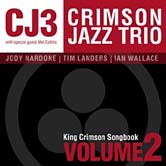 King Crimson Songbook, Vol. 2 King Crimson Songbook, Vol. 2
Inner Knot Records
By Tom Ineck
Forty years on, the music of King Crimson shows no signs of
age, despite an apparent recording hiatus since the group’s
2003 release, “The Power to Believe.” In the interim,
however, the Crimson Jazz Trio—pianist Jody Nardone, bassist
Tim Landers and drummer Ian Wallace—has filled the void
admirably with its exciting reinterpretations of Crimson
classics.
“King Crimson Songbook, Vol. 2” is the long-awaited
follow-up to the group’s 2005 debut, which was reviewed
here. In all likelihood, it will be
the last volume, as Wallace died in February 2007 after a
brief battle with cancer. What remains of this bold
experiment, however, are two masterpieces of the art of
improvisation. Both are excellent jazz takes on a
progressive rock monolith that continues to defy convention.
If possible, the second volume is even more adventurous and
stimulating than the first. “The Court of the Crimson King”
virtually seethes with energy, largely generated by
Wallace’s astounding percussion work. It is further
propelled by Nardone’s surging keyboard attack and Landers’
slippery bass lines. “Pictures of a City,” from KC’s second
album, “In the Wake of Poseidon,” expands on the original’s
rhythmic complexity, shifting easily from a loping tempo to
the skittering bop beat of a run-away train.
The tempo slows briefly for “One Time,” from 1995’s
brilliant comeback record “Thrak.” But, as though unable to
repress their enthusiasm, Nardone, Landers and Wallace soon
lock into a lilting Latin pulse, then turn it over to
Landers for a lyrical solo on the fretless five-string bass.
KC alumnus Mel Collins is featured on soprano sax on a
blazing rendition of “Frame By Frame,” from 1981’s
“Discipline.” Also from “Thrak” comes “Inner Garden,” a
ballad on which Nardone sings the Adrian Belew lyrics with
great beauty and feeling.
“Heartbeat,” from 1982’s “Beat,” is a nifty jazz waltz that
showcases Nardone’s propulsive piano style, which rocks and
swings simultaneously. It also features some inspired drum
breaks by Wallace. The session’s centerpiece is “Islands
Suite,” which draws its inspiration from the 1971 album,
“Islands.” It allows every participant to express
himself—from “Press Gang,” Wallace’s introductory solo
focusing on floor toms and cymbals, to Nardone’s brief but
lovely “Zero Dark Thirty,” to the group explorative theme of
“Formentera Lady,” with Collins on tenor saxophone, which
segues neatly into “Sailor’s Tale” and ends with an
exquisite solo by Landers called “Plank.”
“Lament,” from the 1974 masterpiece “Starless and Bible
Black,” is a fitting finale. The first half of the tune
swings gently with Wallace on brushes and Landers’ moaning
bass capturing the bittersweet nature of the tune. The
second half moves uptempo to a stirring Latin beat with
Wallace firmly in the driver’s seat, ending on a positive
note. If there is a way to keep CJ3 alive after the passing
of its guiding light, we heartily support the idea.
top |
|
|
|
SEAMUS BLAKE QUARTET
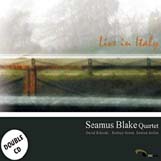 Live
in Italy Live
in Italy
Jazz
Eyes Records
By Tom
Ineck
Seamus
Blake is an inventive tenor saxophonist who has been flying under the
radar for several years, despite his move to New York City in 1992. A
native of Vancouver, B.C., who attended Berklee College in Boston, he
first recorded with Victor Lewis on the drummer’s 1992 release, “Know It
Today, Know It Tomorrow” and has subsequently worked with guitarist John
Scofield, pianists Kevin Hays and Darrell Grant, drummer Billy Drummond
and the Mingus Big Band.
With the
double-disc “Live in Italy,” Blake, 37, boldly steps out in extended
live performances with his quartet, also featuring pianist David
Kikoski, bassist Danton Boller and drummer Rodney Green. It was recorded
in Palermo, Senigallia and Cesenatico in February 2007.
The
excitement level is infectious from the first tune, Blake’s “The Jupiter
Line,” on which he tastefully employs electronic gadgetry to create the
effect of a horn soaring into outer space. Similarly on the funky “Way
Out of Willy,” he uses a wah-wah pedal, reminding the listener of Eddie
Harris’ soulful excursions of the late 1960s. Kikoski contributes a
bluesy solo, while Boller and Green maintain the groove throughout.
The second
movement of Claude Debussy’s String Quartet in G minor is the
inspiration for a gorgeous ballad performance. Blake and Kikoski lock in
unison as Boller and Green provide free, but sensitive embellishments.
The tempo shifts upward for a while before returning to its initial,
meditative mood. Blake’s “Fear of Roaming” is a pensive modal piece that
sets sax and piano against a lively bass line. Boller eventually settles
into a bluesy walk.
Ellington’s
“The Feeling of Jazz” sways gently as Blake weaves brilliant double-time
passages throughout. Kikoski restates the tune’s bluesy, swinging
simplicity, and then builds on the theme with his own rhythmic and
harmonic ideas. Kikoski’s “Spacing” is an aptly named exploration into
the stratosphere, launched with a freely improvised piano solo and
continuing with uptempo energy and witty exchanges by all.
“Ladeirinha” is a ballad in waltz time by Brazilian composer Djavan.
Blake’s tenor again steps up the intensity with double-time statements
against Kikoski’s steady comping, Boller keeping a steady bass pulse and
Green expressing more artistic freedom. Blake telegraphs key phrases of
the familiar melody of “Darn That Dream” in an extended solo sax
introduction before settling down to a true ballad tempo. Never content
simply to state the theme or dwell on the changes, he soon takes flight
in a wonderful solo excursion over the always-reliable rhythm section.
Kikoski and Boller also contribute extended solo statements.
“Dance Me
Home” is a bluesy, typically angular John Scofield tune that serves as a
fitting finale to this lively live set. Kikoski is especially exciting
here, as he digs deep into the groove with Boller and Green urging him
on. Blake ups the ante with a spiraling solo that seems to take off in
several different directions simultaneously. Pretty heady stuff!
With nine
tracks ranging from eight minutes to more than 17 minutes in length,
these two generous CDs are an excellent and very satisfying
approximation of a complete concert performance by the Seamus Blake
Quartet. It is highly recommended for adventurous jazz fans.
top |
|
|
|
TOWNER GALAHER
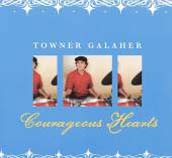 Courageous
Hearts Courageous
Hearts
Towner
Galaher Music
By Tom
Ineck
“Courageous
Hearts” picks up where drummer Towner Galaher’s debut recording left
off. “Panorama” was reviewed in the July 2007 edition of the BMF
newsletter. Again, Galaher’s star-studded ensemble turns in a set of
straight-ahead hard bop that is worth celebrating.
The
instrumentation is similar to the earlier session, adding only trombone
(the great Fred Wesley) to a lineup that also consists of tenor sax
(Craig Handy), trumpet (Brian Lynch), piano (George Colligan), and bass
(Charles Fambrough, the only holdover). On four tracks, the rhythmic
urgency is bolstered by percussionists Gabriel Machado and Ze Mauricio.
Like
“Panorama,” the new CD features strong tunes with intricate horn
arrangements that make the most of the band’s talented front line. All
but two of the nine tunes are Galaher originals, and they are presented
in precise performances averaging about four minutes each. The title
track virtually leaps from the disc with a swinging intensity
reminiscent of Art Blakey and the Jazz Messengers, an undeniable
influence on Galaher. On their solos, Lynch and Handy establish their
formidable technique and brimming soul.
Likewise,
the uptempo “Boogaloobop” features Wesley’s fat tone and soul-jazz
inclinations, but it also is a showcase for Colligan’s keyboard
improvisations and Fambrough’s versatile, shape-shifting bass line.
“Second Line Samba” describes itself well, combining the polyrhythmic
influences of both New Orleans and Rio in a heady, hard-driving brew.
Galaher
slows the tempo to a gently lope and switches to mallets as he
concentrates on floor toms and cymbals on the beautiful “Winter
Sunrise.” Wesley, Colligan and Handy make brief but stirring statements
before the band returns to the head and the leader finishes with a drum
coda. Tadd Dameron’s “Hot House” gets a heated workout with unison horns
setting up a clever rhythmic device that cues solos by Lynch, Colligan
and Handy—all in less than four minutes.
“April 28th”
shuffles along with the relaxed grace of a jazz waltz, creating side
passages for Handy, Lynch, and Colligan to weave their magic in solos
and group interplay. “Londel’s” is a gorgeous, soulful ballad that
showcases Wesley’s gospel shouts and slides. The title theme is briefly
reprised on “Courageous Hearts (Rhythm of Victory)” before the whole
project comes to a glorious conclusion with the Mongo Santamaria classic
“Afro Blue,” a great vehicle for everyone. The only track that extends
beyond seven minutes, it includes well-developed solos by Wesley, Lynch,
and Colligan and stellar percussion work by Galaher and Machado. Indeed,
the band continues to percolate as the track fades, leaving the listener
wanting more.
top |
|
|
|
BOB ALBANESE TRIO with IRA SULLIVAN
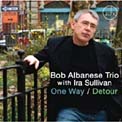 One
Way/Detour One
Way/Detour
Zoho
Music
A relative
unknown, pianist Bob Albanese impresses mightily as composer and player
on his Zoho Music debut, “One Way/Detour.” He moves comfortably between
a post-bop, mainstream style and an infectious Latin tinge. His
often-complex, percussive pianistics are ably accompanied by bassist Tom
Kennedy and drummer Willard Dyson, and six of the 10 tracks are further
enhanced by the presence of the versatile Ira Sullivan on tenor and
soprano saxes, alto flute and percussion.
Albanese’s
technique is immediately established with the quirky opener, “Major
Minority,” as he explores all the permutations of a melodic minor scale.
Rescued from the dustbin of swing history is “Yesterday’s Gardenias,”
once associated with Glenn Miller. Here it gets a thorough brushing-off
with Sullivan on tenor sax still swaggering at age 76. The title track,
“One Way/Detour,” is a devilishly difficult stop-time burner that,
aptly, seems to be moving in opposite directions simultaneously.
One of my
personal favorite here is the surging samba “Morning Nocturne,” with
beautiful chord changes, a pulsating bass line and sizzling percussion
by Dyson, with help from Sullivan. Albanese couples a lilting left-hand
with skittering right-hand improvisations on “Joyful Noise,” another
Latin jazz winner which also features a wonderful bass solo and
impressive press rolls by Dyson.
Sullivan
returns on alto flute to produce a lush, warm tone on the gorgeous
rendition of Thelonious Monk’s “Ugly Beauty.” Albanese’s solo is brief
and understated, so this is a superb showpiece for Sullivan. “Waiting
for Louis” is a bright, snappy tune written as Albanese waited for his
son to be born. The composer notes that he had plenty of time to perfect
the tune, as his wife remained in labor for almost two days!
Another gem
is the brilliant pairing of Albanese with Sullivan, on soprano sax, for
the ballad standard “Midnight Sun.” These masterful musicians take their
time in a dialogue that alternates between unison lines,
call-and-response, harmonic invention and even some well-placed discord.
Albanese creates shimmering, cascading lines as a lovely counterpoint to
Sullivan’s melodic improvisations. Two combined takes of “Friendly Fire”
end the session with nearly 14 minutes of fast-paced group interplay and
solo expression. Sullivan’s burnished tone on tenor sax gives the
extended piece plenty of authority.
The Zoho
Music label has ascended rapidly to the top echelon of jazz record
companies, with an impressive roster of jazz artists, particularly in
the mainstream and Latin jazz genres. Founded in 2003 by veteran music
producer Joachim Becker, it is the home of the excellent Dave
Stryker-Steve Slagle Band, saxophonist Dave Liebman, percussionist Ray
Barretto, harmonica virtuoso Hendrik Meurkens, Arturo O’Farrill and his
Afro-Latin Jazz Orchestra, guitarist Carlos Barbosa-Lima and others. To
that impressive list can now be added Bob Albanese and “One Way/Detour.”
top |
|
|
|
THE BLUE NOTE 7
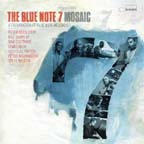 Mosaic: A Celebration of Blue Note Records Mosaic: A Celebration of Blue Note Records
Blue
Note Records
By Tom
Ineck
It is rare
when a clever marketing ploy to sell CDs and concert tickets also
results in a high-quality product capable of standing alone as a work of
great creativity and artistic integrity. So it is with “Mosaic,” a
brilliant project conceived to celebrate Blue Note’s 70th
anniversary as one of the premier jazz labels.
Released in
January, the recording brings together a septet of today’s leading
proponents of post-bop jazz—Nicholas Payton on trumpet, Steve Wilson on
alto sax and flute, Ravi Coltrane on tenor sax, Peter Bernstein on
guitar, Bill Charlap on piano, Peter Washington on bass and Lewis Nash
on drums. Nash, the eldest, was born in 1958, about the time that many
of the classic Blue Note recordings were being waxed. That makes this a
poignant tribute to an earlier, and very influential, generation of jazz masters.
Wisely, the
eight tunes chosen to represent the Blue Note legacy are given new
arrangements that update the sound while remaining true to the
originals. Truly a collective, the ensemble shared in creating the
original charts.
Nash’s
masterful drumming imbues the opening fanfare of Cedar Walton’s “Mosaic”
with an urgency and excitement that continues throughout the piece, a
favorite of Art Blakey’s Jazz Messengers. In his arrangement, Nash makes
no attempt to mimic the great Buhaina, but he admirably retains the
Blakey spirit. Likewise, Payton’s take on Joe Henderson’s “Inner Urge”
is refreshingly new, but still urgent.
“Search for
Peace” gets a lovely arrangement by Renee Rosnes that emphasizes the
McCoy Tyner ballad’s exquisite chord changes and spotlights Coltrane’s
lush tenor and Payton’s searching trumpet. Wilson’s flute carries the
lilting melody line in his treatment of Bobby Hutcherson’s “Little B’s
Poem,” with notable solo contributions also coming from Bernstein and
Charlap.
Wilson also
gives new life to the edgy Thelonious Monk tune “Criss Cross.” No Monk
sound-alike—as if that were possible—Charlap develops the quirky theme
in his own virtuosic manner and the others offer their own distinctive
variations on that theme. Arranger Rosnes returns for “Dolphin Dance,”
creating a sophisticated, yet swinging rendition of the Herbie Hancock
masterpiece.
“Idle
Moments,” written by Duke Pearson and first recorded by guitarist Grant
Green in 1963, gets an aptly bluesy arrangement from Bernstein. While
prominently featured, the guitarist also involves the horns in some
mournful harmonies. Charlap’s arrangement of Horace Silver’s “Outlaw”
brings the session to a close with some tricky stop-time passages
creating a typically hard-bop attitude.
The Blue
Note 7 already are touring heavily, bringing their bop celebration to
venues nationwide, including a February stop in Omaha and a March 26
appearance at the Lied Center for Performing Arts in Lincoln.
top |
|
|
|
THE HOT CLUB OF SAN FRANCISCO
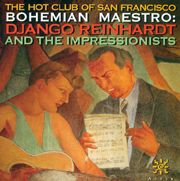 Bohemian Maestro: Django Reinhardt and the Impressionists Bohemian Maestro: Django Reinhardt and the Impressionists
Azica
Records
By Tom
Ineck
Always
looking for ways to expand the narrow confines of the “gypsy jazz” style
inevitably tied to its virtuosic innovators, guitarist Django Reinhardt
and violinist Stephane Grappelli, The Hot Club of San Francisco has
embraced not only the standards of the gypsy jazz repertoire, but more
conventional modern jazz favorites, as well as pop tunes by Lennon and
McCartney and even a couple of classical composers.
But the Bay
area band has surpassed itself in the adventurous spirit of its latest
release. “Bohemian Maestro: Django Reinhardt and the Impressionists” is
an ambitious, and largely successful, attempt to link the legendary
gypsy to the music of classical Impressionism, with the quintet
occasionally augmented by a woodwind quintet, a piano and even a banjo.
For purists of the gypsy jazz persuasion, the result is as mixed as the
stylistic disconnect.
“Bohemian
Maestro” does not lack direct references to Reinhardt—six of the 16
tracks are his compositions—but they tend to be among his more obscure
pieces, such as “Diminishing Blackness,” the stirring “Bolero” and the
generically titled “Improvisation No. 3.” The Aeros Quintet lends its
classical woodwinds to new interpretations of Reinhardt’s “Nympheas” and
“Messe/Improvisation,” the latter expanded from a surviving fragment
intended by Reinhardt as a mass dedicated to the Romany people.
Hot Club
guitarist and leader, Paul Mehling, contributes to the growing gypsy
jazz songbook with two new tunes, and violinist Evan Price adds one.
With bassist Clint Baker and rhythm guitarists Jason Vanderford and Jeff
Magidson, the core quintet is as lively as ever. Pianist Jeffrey Kahane
infuses three numbers with his keyboard pyrotechnics. Mehling switches
to banjo for one of the most refreshing tracks on the record, Jelly Roll
Morton’s “The Pearls.”
Mehling’s
“Le Surdoué” imaginatively recombines fragments of Reinhardt
compositions and improvisations. His “Waltz for M.C. Escher” cleverly
mimics the artist’s optical illusions with a musical equivalent.
The
estimable Impressionists whose melodies tie the whole affair together
are Claude Debussy, Francis Poulenc and Heitor Villa-Lobos, whose gently
swinging “Choros” is a great vehicle for the Hot Club. Debussy’s
immortal “Clair de Lune” closes this challenging and ground-breaking
project, a somewhat more subdued set of performances than we are used to
from these swinging gentlemen, but equally satisfying.
top |
|
|
|
BILL HENDERSON
 Beautiful
Memory: Live at The Vic Beautiful
Memory: Live at The Vic
Ahuh
Productions
By Tom
Ineck
At age 78,
the wonderful jazz singer Bill Henderson finally has a new recording
that puts him in historical perspective and provides a stunning setting
for his still-amazing vocal gifts. The venue is The Vic, a club in Santa
Monica, Calif., near his longtime home in Los Angeles.
Incredibly,
Henderson’s last release was a 1981 tribute to the music of Johnny
Mercer. Since then, he has been featured occasionally on others’
recordings, most notably Charlie Haden’s 1999 release “Art of the Song.”
With “Beautiful Memory,’ Henderson steps fully into the warm glow of the
spotlight.
The
audience at Vic’s has an obvious affection for their local treasure, and
Henderson’s trio—Tateng Katindig on keyboards, Chris Conner on bass and
the great Roy McCurdy on drums—shows an ease and compatibility with the
front man. On the opener, “All the Things You Are,” you believe him when
he joyfully repeats “happy, happy days are mine.” He is just as
persuasive while singing the blues, as his rendition of “Never Make Your
Move Too Soon” soulfully illustrates.
This
12-track set comprised largely of familiar standards never lags and
offers new perspectives on such old chestnuts as “You Are My Sunshine,”
“Royal Garden Blues” and “That Old Black Magic.” Henderson shouts a
bluesy “Sunshine” with a broad and breezy style in the upper register,
inspiring the audience to a soul clap. He playfully swings the lyrics on
“Garden,” and recites the ballad “Black Magic” with very effective
hesitation phrasing before escalating the tempo to a swinging groove.
Harold
Arlen’s wonderful “Sleepin’ Bee” gets the tender ballad treatment it
deserves, with Henderson drawing out the lyrics in long, languorous
phrases. Henderson dives into the Latin mainstream with the rarely heard
“The Moon Is Yellow.” He brings new meaning to Elton John’s modern
standard “Sorry Seems to Be the Hardest Word,” also covered a few years
ago by Karrin Allyson. “The Song is You” fairly bursts with joy.
Johnny
Mandel’s melancholy ode to love and loss “Living Without You” is a great
choice for Henderson’s endearing confessional style. “Tulip or Turnip”
is a clever finale, bringing good humor to self-doubt.
Henderson’s
voice is a warm and supple instrument that is never too far from the
roots of gospel, soul and the blues. With “Beautiful Memory,” he has
reestablished his reputation as one of the best male jazz vocalists of
the last 50 years. Let’s hope there are many memories yet to come.
top |
|
|
|
SONNY ROLLINS
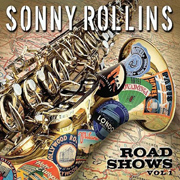 Road
Shows, Vol. 1 Road
Shows, Vol. 1
Doxy
Records
By Tom
Ineck
Sonny
Rollins’ tightrope-walking, extended improvisations on the tenor
saxophone are best appreciated in live performance, but—like anyone—he
is not always at the top of his game. That’s what makes “Road Shows,
Vol. 1” so enjoyable. It serves up some of the best Rollins recordings
captured over the last several decades and instantly re-establishes his
credentials as a giant among jazzmen.
Totaling
nearly 72 minutes, the seven tracks were recorded between 1980 and 2007,
reminding us again of the tremendous breadth and depth of the Rollins
oeuvre. Remember, Rollins has been recording since the early 1950s and
continues to perform at age 78.
“Best
Wishes,” from a May 25, 1986, performance in Tokyo, virtually surges
with that famous Rollins enthusiasm and visceral power. From there we
are transported to Toulouse, France, for a 2006 concert and an
incredible version of the ballad standard “More Than You Know.” It
offers the trademark Rollins at his finest, inserting and embellishing
familiar musical quotations with ease. Previously unrecorded, “Blossom”
is taken from a 1980 jazz festival in Sweden. It has Rollins on fire,
ably aided and abetted by pianist Mark Soskin, bassist Jerome Harris and
drummer Al Foster.
Congress
Hall in Warsaw 1980 is the unusual setting for an emotionally charged
performance of the ballad “Easy Living.” Soskin apparently was provided
with a piano that had not been properly tuned and voiced, but he
overcomes its shortcomings with a great solo. In his solo cadenza,
Rollins takes the tune—and the listener—on a bold excursion to new,
uncharted and thoroughly thrilling territory.
Rollins
revisits “Tenor Madness” in spectacular form during a 2000 performance
in Tama City, Japan. His squalling, snarling sax righteously explores
the blues changes from every angle. No Rollins collection would be
complete without a calypso, and his “Nice Lady” serves the purpose well
in a 12-minute performance recorded in Victoria, B.C., in 2007. Anderson
turns in a fine extended solo before turning it over to Uncle Sonny.
Rollins has
maintained a loyal coterie of musicians over the years and most of them
are represented here—trombonist Anderson, guitarist Bobby Broom,
pianists Soskin and Stephen Scott, bassists Bob Cranshaw and Harris, and
drummers Foster, Victor Lewis, Perry Wilson, and Steve Jordan. The
closer, “Some Enchanted Evening,” is a rare and very special trio
performance with bassist Christian McBride and drummer Roy Haynes.
Of course,
the amazing music contained in “Road Shows, Vol. 1” begs the obvious
question. When can we expect more of the best from the living master of
the tenor sax?
top |
|
|
|
EDDIE DANIELS AND ROGER KELLAWAY
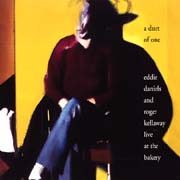 A
Duet of One: Live at the Bakery A
Duet of One: Live at the Bakery
IPO
Recordings
By Tom
Ineck
Aptly
named, “A Duet of One” rightfully implies the singularity of purpose,
the extrasensory dialogue and the compatible virtuosity of clarinetist
Eddie Daniels and pianist Roger Kellaway. It also implies the
seat-of-the-pants immediacy of its live setting, The Jazz Bakery in Los
Angeles, where it was recorded March 30 to April 2, 2005.
Daniels and
Kellaway quickly establish their amazing talents with “I’m Getting
Sentimental Over You,” taken at a swinging mid-tempo that gently urges
the participants to ever higher feats of improvisation and
one-upmanship. Equally proficient on tenor saxophone, Daniels here
eschews that instrument’s larger, robust and metallic sound for the
brighter, woodier tone of the clarinet. The result is a more level
playing field for the two featured instruments, and the two artists
respond accordingly.
Daniels’
composition “Slow Dance” is, indeed, a swirling, terpsichorean delight
that inspires splendid solo statements from each of the dance
“partners.” His tune “Adagio Swing” liberates Daniels to soar on a solo
clarinet flight before turning it over to Kellaway, whose two-fisted
technique simultaneously maintains a pulsing, left-hand rhythm pattern
while ascending into the upper registers with the right.
Their
whimsical, imaginative performance of “I Want to Be Happy” is as
carefree and exuberant as its title. Free of a rigid rhythm pattern,
Daniels and Kellaway carry on a very high-brow jazz conversation—making
solo statements, responding with witty repartee and occasionally mixing
it up in a polite “shouting” match. Hoagy Carmichael’s “New Orleans”
gets a relaxed, bluesy reading in which the two instruments blend
beautifully in pitch and mood.
Kellaway’s
loping, rhythmically ambiguous “This Is the Time” ironically leaves the
listener wondering exactly where the “time” is. Would-be dancers,
beware! The two return to more familiar ground with a dazzling uptempo
display of technique on the standard “After You’ve Gone.” They trade
fours with ease, continuously upping the ante for the next smoking
chorus and inspiring the audience to enthusiastic applause.
“Blue
Waltz,” another Daniels tune, is a perfect vehicle for the composer’s
warm and woody clarinet at a meditative ballad tempo. On his ballad
“Love of My Life,” it is Kellaway’s turn to romanticize and he does so
with tenderness, grace and beauty. “We’ll Always Be Together” is
Daniels’ lyrical statement of hope and the embodiment of this joyful and
fruitful duo collaboration.
Not
released until 2008, this very live session is another jewel from IPO
Recordings, which is responsible for another of last year’s best jazz
CDs, the collaboration between James Moody and Hank Jones called “Our
Delight.” The label has wisely chosen to focus on seasoned musicians who
are still performing at a very high level of creativity and have not
gotten the attention they deserve.
top |
|
|
|
MARK WINKLER
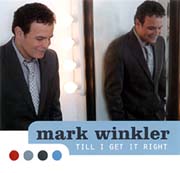 Till
I Get It Right Till
I Get It Right
FreeHam
Records
By Tom
Ineck
“Till I Get
It Right” is the welcome return of jazzy vocalist Mark Winkler, six
years after his wonderful tribute to Bobby Troup, the composer of such
hip classics as “Route 66.” His latest release is a showcase for his own
lyric-writing talents and his ability to shift gears from uptempo
swingers to romantic ballads.
Based in
Los Angeles, Winkler has assembled a crack West Coast band that includes
saxophonist Bob Sheppard, guitarist Anthony Wilson, trumpeter Ron Blake,
keyboardist Jamieson Trotter, bassist Dan Lutz and drummer Steve Hass.
On the
title track, Trotter doubles on piano and Hammond B3 to create a funky,
propulsive kick with a walking bass line and an wailing tenor sax solo
that combines for a dazzling opener. Winkler’s smooth, relaxed delivery
reminds the listener why he is often compared with such vocal stylists
as David Frishberg, Michael Franks and Mark Murphy, a Winkler fan who
contributed the liner notes.
Winkler
cleverly celebrates gormandizing while thumbing his nose at the
diet-crazy world with “How Can That Make You Fat?” On the Marilyn Harris
tune “Cool,” he croons his original lyrics soulfully and sexily in duet
with Cheryl Bentyne of Manhattan Transfer. “Cool” also features some
very cool bass work by Lutz.
“Spring Is
Where You Are” is a love ballad written by Steve Allen, another prolific
tunesmith with a penchant for clever lyrics and the sound of cool.
Wilson’s guitar is a perfect foil for Winkler’s touching rendition.
Joshua Redman’s “lowercase,” with lyrics by Winkler and Lori Barth,
seems an unconventional choice, but the bluesy, moody tune works well
and is assisted by Sheppard’s marvelous tenor sax playing and the
intense drumming of Hass.
Winkler
pays homage to Truman Capote on “Sissies,” with music by collaborator
Louis Durra. “In a Lonely Place” is another Marilyn Harris composition,
this time a sensitive ballad with Winkler lyrics and featuring Blake on
muted trumpet and Trotter on piano. The Harris-Winkler tune “Future
Street” is an easy-swinging blues with enticing lines such as, “There’s
a girl that’s waiting for me, with tomorrow in her eyes.”
The Ivan
Lins samba “Evolution” gets a new coat of paint with lyrics by Brock
Walsh that draw the conclusion that “evolution is a state of mind.”
Winkler’s descriptive words for Durra’s “How to Pack a Suitcase” tell a
witty tale of the sweet sorrow of parting. “In the Moment” is a romantic
Mike Melvoin tune with a Latin lilt and some nice acoustic guitar-piano
trades.
“You Might
as Well Live,” a dreamy, bittersweet ballad by Dan Siegel with lyrics by
Winkler and Harris, closes the set with a message of spiritual courage
and triumph over life’s challenges and disappointments.
top |
|
|
|
THE SONS OF BRASIL
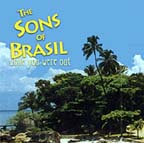 While
You Were Out While
You Were Out
Standing
Bear Records
By Tom
Ineck
With a
reputation so firmly established in the world of Latin jazz and, in
particular, those subgenres of Brazilian samba, bossa nova and choro, it
comes as a great surprise that The Sons of Brazil had, until recently,
only one recording in 17 years. To the band’s enthusiastic fan base,
which extends well beyond its Kansas City, Mo., home, the arrival of
“While You Were Out” is long overdue.
The Berman
Music Foundation has followed the evolution of The Sons and its featured
players with much interest, featuring the ensemble as part of the local
Jazz in June series in 2002 and 2007 and catching them whenever possible
on their home turf.
For their
latest outing, trumpeter Stan Kessler has once again assembled some of
KC’s finest musicians, including guitarist Danny Embrey, pianist Roger
Wilder, bassist Greg Whitfield, drummer Doug Auwarter and percussions
Gary Helm. On two tracks, Luiz Orsano is added on percussion.
It is
refreshing that most of the 13 tunes were written by band members, with
only two covers by Brazilian master Antonio Carolos Jobim, one by Joao
Bosco and one by Jose Roberto Bertrami. Kessler’s warm and breezy
flugelhorn set the mood for his set-opening tune, “Joao.” Embrey and
Wilder expand on that mood with gently swinging solos.
Whitfield
establishes the funky, fusion underpinnings of Bertrami’s “Partido
Alto,” inspiring Wilder to a Herbie Hancock-style foray on the electric
keyboard, and Kessler’s playing is reminiscent of the late, great
Freddie Hubbard in his bright, spirited solo. Embrey contributed three
tunes, including the melodic masterpiece “Journey,” which gives the
guitarist an opportunity to explore imaginative changes with his deft
fretwork.
Kessler
gives the Jobim classic “Desafinado” a respectful arrangement that
emphasizes his luxurious flugelhorn tone against Wilder’s piano
harmonies and a brief, but brilliant Embrey solo. With Kessler’s
“Salvador,” the band returns to a pumping, rhythmic feel, featuring the
composer’s soaring trumpet and Orsano adding another layer of
polyrhythmic percussion.
“Bala Com
Bala,” by Bosco, has a clever circular pattern that gives the piece an
infectious forward motion and keeps the musicians and the listener
enthralled. Kessler’s playing is simply virtuosic in its confidence and
execution. “Migration” is a gentle Embrey composition with some
intriguingly melancholy “blue” chords that resolve upward, finally
creating a more affirmative mood. The title track, a collaboration
between Whitfield and Kessler, churns with a driving bass line, some
two-fisted playing by Wilder and some high-note pyrotechnics by Kessler,
capped by a percussion tour de force.
Jobim’s
“Surfboard” does seem to ride the crest of a wave. You can almost feel
the ocean spray in its leaping chord structure and the lilting
performances by all. “I’ve Got Samba” is Kessler’s rambunctious tribute
to the genre that popularized the dance-friendly music of Brazil for
millions of Americans. Embrey’s romantic ballad “Tell Me Now” is
exquisitely beautiful, and it gets the perfect backing with Kessler’s
sensitive flugelhorn and Wilder’s understated piano anchoring the
guitarist’s melodic treatment. Wilder contributed the gently swaying and
curiously titled “Esso Bees.” The set ends with Kessler’s strutting,
bluesy “If It Feels Good.”
Perhaps as
a nod to their loyal fans in Lincoln, most of the photos included in the
CD liner are from that memorable Jazz in June concert of 2007, shot by
BMF photographer Rich Hoover. “While You Were Out” is definitely IN, in
the coolest sense of the word.
top |
|
|
|
DAVID BOSWELL
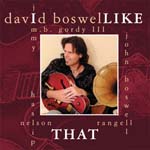 I
Like That I
Like That
My Quiet
Moon Records
By Tom
Ineck
Guitarist
David Boswell is among the many fusion jazz pickers who openly emulate
Pat Metheny, arguably the most influential guitarist of the last 30
years. Boswell, a San Francisco native, goes so far as to characterize a
Metheny concert that he attended at age 16 as "a religious experience."
Boswell’s
approach to the music is not mere slavish duplication. With his third
solo effort, 2009’s "I Like That," he builds on the fusion model with a
strong band of like-minded adventurers, including Yellowjackets bassist
Jimmy Haslip, saxophonist Nelson Rangell (on three tracks), his brother
John Boswell on piano, and drummer M.B. Gordy III. The result is a
product with crossover potential with jazz, rock and New Age fans.
With Boswell
on assorted electric and acoustic guitars, mandolin, synthesized guitar,
keys and voice, the title track is a paean to Metheny’s breezy style and
wide-ranging technique. Like his mentor, Boswell builds the intensity to
a breath-taking climax. On "Tightrope," A serious funk backbeat,
Rangell’s keening sax and Haslip’s solid rhythmic foundation form a
potent backdrop for Boswell’s rock guitar excursion. "It’s Possible"
combines unison guitar and sax lines to a decidedly mellowing effect,
rather like a cup of herbal tea.
Metheny is
again evoked on the beautiful "Awaken the Gentle Giant," with
multi-tracked vocal harmonies and John Boswell’s meditative piano
leading into a dynamic Haslip solo and a soaring synth guitar interlude.
"Little Steps on a Long Road," like "Awaken," marries a soaring guitar
with wordless vocals. One of the most interesting tracks is "Come and
Get Me," with Boswell playing all the instruments, including guitars,
keys, synthesizer, bass and voice.
"Across the
Plains" is an unfortunate allusion to Metheny’s Plains-themed tunes, but
the Missouri-born Metheny comes by his inspiration naturally. On
"Westward Path" the solo Boswell evokes a rural flavor on mandolin and a
keyboard "harmonica" sound, avoiding easy comparisons and creating a
simple, but endearing melody.
While Boswell
occasionally takes a bold step away from the Metheny camp, he eventually
returns to safer ground. Until the guitarist finds a truly individual
sound and breaks the Metheny mold, he will forever be compared with his
elder, who is a much more sophisticated composer and player.
top |
|
|
|
JAMES MOODY AND HANK JONES QUARTET
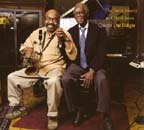 Our Delight Our Delight
IPO
Recordings
By Tom Ineck
It is,
indeed, “Our Delight” to listen to this historic recording pairing the
still-vibrant jazz masters James Moody and Hank Jones. At the time of
the date in June 2006, Moody was 81 and Jones was 87, but they play with
the vitality and imagination of young lions. With a generous program
largely comprised of tunes by Dizzy Gillespie and Tadd Dameron, IPO
Recordings has again produced a well-polished gem of lasting value.
The quartet
is completed with bassist Todd Coolman and drummer Adam Nussbaum,
excellent choices for a swinging, tasteful session that stays mainly in
the mid-tempo range.
On the
title track, by Dameron, Moody leaps in with his trademark tenor sound
as Jones comps and fills with grace and assurance. Jones’ own solo
echoes Moody’s mood. “Birk’s Works” gets a laid-back, bluesy treatment
and features a bass solo on which Coolman pays his respects to Ray
Brown.
Jones
delves deeply into the changes on “Con Alma.” Moody’s tenor caresses the
melody on Dameron’s “Lady Bird,” then explores all the harmonic
possibilities in an extended solo. Jones takes his cue and ups the ante
with deft turns of phrase.
Taken at
breakneck tempo, Sonny Stitt’s “Eternal Triangle” is the most
challenging tune here, pressing Moody through the changes and keeping
Jones on his toes. They meet the challenge with surprising gusto and
quick reflexes, and Nussbaum’s four-bar breaks stoke the fire. Moody and
Jones pair off for a lovely, romantic reading of “Body and Soul.”
“Good
Bait,” written by Dameron and a familiar favorite of Gillespie’s, swings
breezily, thanks to Nussbaum’s constant support. Moody switches to flute
on his sly and witty composition “Darben the Red Foxx.” Back on tenor,
he evokes a sultry, breathy noir ambiance on a nine-minute version of
Dameron’s “Soul Trane.” The tempo accelerates one more time for
Gillespie’s “Woody ‘N’ You,” a showcase for Jones and for Nussbaum’s
effortless percussion.
“Old Folks”
is another duo, this time with Moody stating the classic melody on flute
and Jones sensitively providing the accompaniment. As an added bonus,
Jimmy Heath’s “Moody’s Groove” is sung by Italian native Roberta
Gambarini, who draws convincingly from the vocal tradition of Ella
Fitzgerald, Sarah Vaughan and Carmen McRae, right down to the graceful
scatting.
An instant
classic, “Our Delight” is nearly 80 minutes of delightful musical
repartee between two legends of jazz history. It comes in an attractive
gatefold package with color portraits of Moody and Jones and informative
notes by bassist Coolman.
top |
|
|
|
DAVE HOLLAND SEXTET
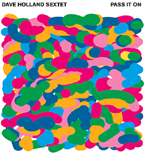 Pass It On Pass It On
Dare2 Records
By Tom Ineck
After a
decade in which bassist Dave Holland’s format of choice was a quintet
also consisting of saxophone, trombone, vibraphone, and drums, he has
changed the formula to a six-piece band that adds trumpet and piano to
the mix, while dropping the vibes.
It may seem
like a subtle shift in emphasis, but the results are magical on “Pass It
On.” The three-horn front line creates fuller harmonies and the piano is
a more harmonically rich and rhythmically muscular instrument than the
vibes. Once again, Holland has found a way to keep the music fresh and
exciting.
As always,
Holland leads a sonically democratic outfit, allowing his bandmates
plenty of room for improvisation and group interplay, even though he
wrote all but one of the nine tunes. With a lineup that includes Antonio
Hart on alto sax, Robin Eubanks on trombone, Alex Sipiagin on trumpet,
Mulgrew Miller on piano and Eric Harland on drums, Holland can rest
assured that they will deliver.
Eubanks’
aptly titled opener, “The Sum of All Parts,” immediately establishes the
value of the sextet by “building” the group from its various “parts,”
beginning with trombone and percussion, then gradually adding alto sax,
trumpet, bass and piano in funky syncopation. Eventually, the band comes
together to state the melody en masse, followed by a brilliant bass solo
and more group dynamics. It’s an ingenious technique for introducing the
new band and the new sound.
“Fast
Track” has the horns bursting out of the gate uptempo, but the tune also
is a showcase for Miller’s wonderful keyboard work. Holland introduces
“Lazy Snake” with a slithering bass solo, before turning the melody over
to the horns. A longtime Holland employee, Eubanks takes the first solo,
followed by Sipiagin and Hart. The tempo accelerates again for “Double
Vision,” a rhythmically complex piece that features another inspired
Eubanks solo and some incredible drum pyrotechnics.
Miller
begins “Equality” with a sensitive piano statement, later joined by Hart
on the melody, with tasteful accompaniment by Holland and Harland. The
other horns enter near the end, but only as accompaniment to Hart’s
soulful, extended improvisation. “Modern Times” is a bouncy, mid-tempo
tune that beautifully harmonizes the horns over a pulsing rhythm.
Eubanks and Miller get brief solos, but the ensemble is the star here.
At nearly
14 minutes, “Rivers Run” begins with Hart blowing like Coltrane over an
intense modal riff. A true melodic theme doesn’t emerge until after
Holland solos, about halfway through the tune. Eubanks, Harland, and
Sipiagin take solos between accelerating ensemble passages that seem to
mimic the dangerous rapids implied by the title. The stately
“Processional” showcases Sipiagin’s deft trumpet work, and the title
track closes the proceedings with a funky urgency and a reiteration of
Holland’s high standard of group interplay, as bandmates alternately
weave harmonies and take solos.
top |
|
|
|
DENISE DONATELLI
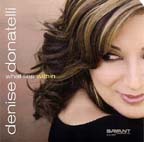 What Lies Within What Lies Within
Savant Records
By Tom Ineck
With her sophomore release, Denise Donatelli beyond a doubt
establishes herself as one of the brightest vocal stars on the
horizon. “What Lies Within” is a recording of astounding depth,
with exciting arrangements by pianist-producer Geoffrey Keezer
and imaginative performances by all involved.
Donatelli’s voice is exhilarating as it takes flight in the
compatible company of Keezer, reed master Bob Sheppard,
guitarist Peter Sprague, bassist Hamilton Price and omnipresent
drummer Marvin “Smitty” Smith. Other noteworthy contributions
come from trumpeter Carl Saunders and percussionist Alex Acuna.
The
listener leaps to attention with the comparatively brief opener,
an exuberant three-minute reading of “My Shining Hour.”
Donatelli delivers the lyric and a scat interlude with
confidence and aplomb, as Keezer on piano, Sheppard on tenor and
Sprague on guitar set the solo performance standard at a very
high level. The Ivan Lins tune “Sails (Velas Icadas)” is given a
funky, syncopated backbeat that draws inspired solos by Keezer
and Sheppard on alto sax. Then Donatelli and Sheppard lock
melody lines in tandem.
Perhaps the highlight of the entire recording is Donatelli’s
exquisite rendering of Chick Corea’s “Crystal Silence,” with
lyrics by Neville Potter. This time, Sheppard soars on soprano
sax, flute and alto flute, and Donatelli goes on a wordless
vocal excursion in perfect harmony. On the samba “I Love it When
You Dance That Way,” she chimes in unison with Saunders’
flugelhorn as though truly dancing. Sprague on nylon-string
guitar and Smith on brushes create the ideal rhythm.
Donatelli proves just as capable with the phrasing and breathing
demands of a ballad on the standard “We’ll Be Together Again,”
which also features a wonderful bass solo by Price. Again her
phrasing stands out in the long, snaking lines of the modal
“Like an Old Song,” where her voice deftly weaves with the
difficult piano and tenor sax improvisations. Clifford Brown’s
“Daahoud” gets a new lease on life with “Beloved,” an
imaginative reworking that has Donatelli exhibiting some very
sophisticated lyrical gymnastics.
Keezer’s own “Four Walls” is the setting for another sensitive
Donatelli performance, which is enhanced by the cello work of
Giovanni Clayton, Sprague’s nylon-string guitar and the organ
voicings of Carlos Del Rosario. Saunders contributes some very
cool muted trumpet on a bluesy rendition of Joni Mitchell’s “Be
Cool.” The whole band delivers on the magical song “Make This
City Ours Tonight.” J.J. Johnson’s classic “Lament,” here
entitled “This Lament,” closes the recording with a mournful,
yet hopeful piano-voice duet.
In
a market flooded by aspiring—and largely mediocre—vocalists,
Donatelli easily rises to the top. With two excellent releases
(her debut, “In the Company of Friends, was released in 2005),
she is well on her way to the recognition she so richly
deserves.
top |
|
|
|
DANILO PEREZ
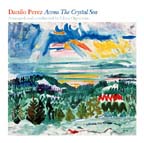 Across the Crystal Sea Across the Crystal Sea
EmArcy
Records
By Tom Ineck
Some critics reject any attempt to marry the jazz esthetic with
the classical tradition, ignoring the fact that many jazz
artists have created some of their most memorable work with
orchestral accompaniment, including Charlie Parker, Stan Getz,
George Shearing, Bill Evans and Oscar Peterson. Properly
arranged and conducted, the lush backdrop can actually enhance
the artist’s contributions.
So
it is with Danilo Perez’s “Across the Crystal Sea,” a collection
of tunes bearing the trademark romantic treatment of arranger
and conductor Claus Ogerman, best known for similar projects
with Antonio Carlos Jobim, Wes Montgomery, Diana Krall and the
above-mentioned Getz, Evans and Peterson. Granted, Ogerman’s
arrangements are neither ground-breaking nor complex, but they
are legendary in creating an evocative mood over which the
soloist can soar.
Ogerman himself wrote six of the eight pieces, some of which are
based on themes by the likes of Sibelius, De Falla, Rachmaninoff
and Massenet. Not to be totally compromised by the classics,
Perez is joined by bassist Christian McBride, drummer Lewis Nash
and percussionist Luis Quintero.
Quintero’s bongos introduce the beautiful title track, based on
a melody by Hugo Distler. Perez soon puts his unmistakable stamp
on the performance with alternating block chords and single-note
runs. McBride sets up “Rays and Shadows” with a repeated bass
line, later shifting to a walking rhythm for Perez to play
against. “The Purple Condor” allows the jazz group to flourish
with Nash and Quintero mixing up the Latin rhythms, McBride
ruminating with agile, funky bass excursions and Perez racing up
and down the keys with breath-taking skill.
Perez carefully spells out the melody of the romantic ballad “If
I Forget You,” based on a Rachmaninoff theme and taken at a very
slow tempo. The strings and woodwinds slowly enter, but Perez
remains the center of attention in this gorgeously realized
piece. It is the strings that soar on “The Saga of Rita Joe,” as
they build the mood for nearly three minutes before Perez takes
over the theme and further expands on it in harmonic variations.
Ogerman’s gorgeous “Another Autumn” closes the set with Perez
front and center in a masterful, emotive display, with McBride
contributing some lovely counterpoint.
Cassandra Wilson lends her haunting, wispy voice to two tracks.
“Lazy Afternoon” is a wonderful showcase for her soulful,
throaty vocal, even though Perez and company don’t have much to
offer here. She also performs “(All of a Sudden) My Heart
Sings,” by Harold Rome. Her voice seems to ride the chord
changes as they slowly rise, like a hopeful love. Again, Perez
enters late in the tune, but with magical effect.
top |
|
|
|
RALPH LALAMA QUARTET
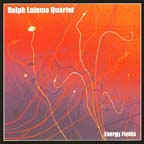 Energy Fields Energy Fields
Mighty Quinn
Productions
By Tom Ineck
A long-laboring, underappreciated great of the tenor saxophone,
Ralph Lalama may finally get his due as a leader with “Energy
Fields.” At 57, Lalama has an extensive resume going back to the
early 1980s—usually in the big band context of drummer Mel
Lewis, the Carnegie Hall Jazz Band and the Vanguard Jazz
Orchestra—but he has only a handful of recordings under his own
name, and this is his first U.S. release.
It’s a dandy. Lalama’s tight quartet also features guitarist
John Hart, bassist Rick Petrone and drummer Joe Corsello,
allowing the tenor plenty of space and plenty of strong support
in a program largely comprised of familiar standards done in
unfamiliar ways.
For
example, take “Old Folks,” a funky Hart arrangement that is
miles from the predictably sentimental approach usually taken.
Likewise, Lalama’s arrangement of “Like Someone in Love,” which
takes its cue from the searching, adventurous style and fat tone
of Sonny Rollins, even as it retains its conventional ballad
tempo.
The
highly accelerated “Just in Time” segues from a brief tenor
intro to a bass interlude and back to tenor, then to an inspired
Hart solo and a powerful flurry of percussion by Corsello.
Perhaps Victor Herbert’s “Indian Summer” and Alec Wilder’s
“Blackberry Winter” get the most conventional readings simply
because they are great melodies that require no embellishment.
Nonetheless, Lalama delivers imaginative tenor statements on the
mid-tempo “Indian Summer” and the ballad reading of “Blackberry
Winter.” Hart also contributes sensitive, well-thought-out solos
on both tunes.
Among the lesser-known tunes is the opener, a wonderful
rendition of Woody Shaw’s “The Moontrane,” a dynamically charged
composition that puts everyone through the paces in rapid
succession. Charlie Parker’s sly “Buzzy” wends its way through
bluesy bop changes at a blistering tempo that pushes soloists
Hart and Lalama to the outer limits and provides some nice drum
breaks for Corsello. “United” is one of Wayne Shorter’s most
interesting tunes. Its dramatic, lilting lines and fast shuffle
tempo encourage equally dramatic solo flights by Hart, Lalama
and Petrone.
Lalama’s own “Nonchalant” is an irresistible samba that has the
saxophonist front and center, as Corsello contributes some
evocative mallet and cymbal work and Petrone keeps the pulse
with a resounding bass tone.
Here’s hoping that Lalama continues to nurture his solo career
here at home and that domestic labels continue to sit up and
take notice.
top |
|
|
|
KELLY ROSSUM
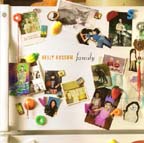 Family Family
612 Sides
By Tom Ineck
Trumpeter Kelly Rossum has firmly established his reputation
since leaving his Lincoln, Neb., home for the Twin Cities, where
he has found compatible bandmates—pianist Bryan Nichols, bassist
Chris Bates and drummer J.T. Bates—and a creative climate
conducive to his sometimes quirky musical proclivities.
The
Berman Music Foundation brought Rossum to Lincoln for a club gig
in November 2005 and reviewed his 2004 release, “Renovation.”
Rossum draws from the modern trumpet traditions of Don Cherry
and the great Lester Bowie, especially on the opening title
track. Like Bowie, he uses the muted horn to evoke the very
roots of jazz, while sounding thoroughly modern. He uses the
technique again on the delightful “Mr. Blueberry.”
On
“This is Where My Head Is At,” Rossum begin with a fairly
conventional melody line on the open horn, before turning it
over to Nichols for an extended foray. Rossum returns with a
noticeable increase in intensity, aided and abetted by J.T.
Bates, who comes on like Tony Williams backing Miles.
The
standard “Pure Imagination” is turned every which way but loose,
with Rossum first stating the theme then leading the band
through a witty deconstruction that, indeed, displays an
abundance of imagination. Nichols’ “A Word from Our Sponsors”
gallops along with abandon before concluding suddenly with a
perfectly logical resolution.
There is an appropriate, childlike lilt to “Somebody Come and
Play.” Rossum soars on the open horn, with Nichols providing
lovely accompaniment and a breezy, relaxed solo. “Interlude” is
a hauntingly beautiful, Nichols-penned ballad that provides a
perfect vehicle for a more conventional, vibratoless playing
style.
Frank Loesser’s “If I Were a Bell” gets the full Rossum
treatment, eight minutes of fascinating twists and turns on a
familiar theme. The trumpeter employs the whole range of his
instrument, ringing the changes with confidence. Nichols
cleverly implies the melody while reaching for unexpected
variations. As always, the Bates brothers provide a solid
rhythmic foundation.
Returning to the muted horn, Rossum evokes Miles Davis on the
ballad “After the Snow.” A brief reprise of the titular “Family”
theme rounds out this very satisfying recording by one of the
most original trumpeters on the scene today.
top |
|
|
|
THE STRYKER/SLAGLE BAND
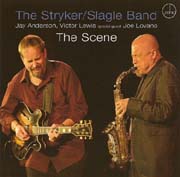 The
Scene The
Scene
Zoho Music
By Tom Ineck
Guitarist Dave Stryker and saxophonist Steve Slagle continue
their run of inspired collaborations on the Zoho Music label
with “The Scene,” which contains the usual demanding original
compositions—four by each of the two leaders—and flawless
execution.
On
their fourth CD as co-leaders, Stryker and Slagle are joined by
old friends and bandmates Jay Anderson on bass and Victor Lewis
on drums, and tenor saxophonist Joe Lovano returns as a special
guest on four of the nine tracks. To read a review of the band’s
previous release, “Latest Outlook,”
click here.
Typically, Slagle’s funky opener, “Skee,” has everyone playing
at the top of their game. Lovano seems especially intrigued by
the changes, as he merrily improvises on them. Stryker’s
skittering guitar solo is punctuated with breathtaking runs and
imaginative chords. Anderson and Lewis are the epitome of cool
rhythmic intensity.
The
title track is a Stryker original with a swinging theme on which
the guitarist weaves his magic. Slagle delivers a spiraling alto
solo, followed by an elegant Anderson bass solo. “Six Four Teo”
teams Lovano and Slagle in unison as Stryker builds the momentum
with interesting rhythm chords. The tune’s 6/4 time signature is
an excellent vehicle for Lewis’ crackling trap work.
Lewis again excels on the whimsical, but difficult “Two Sense.”
Its stop-and-start nature keeps everyone on his toes. “Kindred
Spirits” is another lovely Stryker composition somewhat in the
breezy style of Pat Metheny, with Slagle on alto against the
composer’s ringing rhythm guitar. Stryker’s solo soars in joyous
abandon.
Slagle’s sad ballad “Hopewell’s Last” is an intricate
composition brilliantly pairing Lovano’s tenor with the
composer’s mournful soprano sax. It is dedicated to Slagle’s
late brother, Stuart. After this heart-wrenching tribute,
Stryker’s uplifting “Brighter Days” is made to order, and it
delivers with swinging gusto as Lovano makes his final
appearance on the session.
Rahsaan Roland Kirk’s hauntingly beautiful “Fingers in the Wind”
is a most interesting choice, and it works beautifully as a duet
with Slagle on flute and Stryker on acoustic guitar. Slagle’s
breathy, percussive performance is in keeping with Kirk’s
innovative technique and seeking spirit. The genesis of
“Strikology” is evident in its closer’s title. It’s an uptempo
affair that puts the guitarist firmly in the driver’s seat.
We
heartily recommend that you make “The Scene.” To make it is to
dig it.
top |
|
|
|
MELVIN SMITH
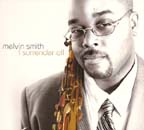 I
Surrender All I
Surrender All
MGS Music
By Tom Ineck
At
34, saxophonist Melvin Smith is deserving of more recognition.
The Jacksonville, Fla., native is an excellent composer and
interpreter with a broad range of stylistic influences and
enough technique on alto, soprano and tenor horns to make “I
Surrender All,” his second release as a leader, a very enjoyable
listening experience.
Smith brings a warmth and a sense of spirituality to everything
he does, from the gospel roots of the title track to the playful
funkiness of “Burgoyne Dr.,” named for the street on which he
grew up, to the heart-felt tribute “Mom and Pop,” a lithe and
lilting waltz performed to perfection by Smith on tenor sax.
The
uptempo, uplifting “We Shall Not Be Moved / Firm Roots (For Dr.
King)” has its obvious inspiration in the ongoing struggle to
realize Dr. Martin Luther King’s dream of racial equality. The
civil rights anthem meshes well with “Firm Roots,” a modern
standard by pianist Cedar Walton. “Speak to My Heart” is a
lovely melody, with trumpeter Reggie Pittman and trombonist
Andre Murcheson adding harmonic depth.
Smith returns to the subject of family with his composition
“Baby Sister,” a surging Latin tune with some very nice piano
work by Steve Lee and a trumpet solo by Pittman. The bluesy
piano of Gregory Royals is a marvelous foil for Smith’s
saxophone on a unique duo arrangement of “Amazing Grace.”
Bobby Watson’s great tune “In Case You Missed It” is wisely
chosen as a vehicle for Smith’s rapid-fire also sax
improvisations, with accompaniment by Lee, bassist Lino C. Gomez
and drummer Sam Knight. On “The Joy of the Lord,” Smith and
company express the joy inherent in the title, with a
But
it is the closer, Horace Silver’s classic “Peace,” that stands
out in Smith’s thorough exploration of the beautiful changes and
all the emotional and spiritual ramifications of the piece. On
alto sax, he again pairs off with a pianist—this time Hubert
Eaves III—to create a profound musical dialogue.
After a slight pause, it is followed by an extended tenor sax
workout with references to “Softly, as in A Morning Sunrise” and
backed only by bass and drums. Herein, Smith pays homage to
Coltrane, Rollins, Joe Henderson and other masters of the tenor
sax who are among his apparent influences.
Smith explains his very personal musical intentions in the liner
notes:
“As
one grows, a certain level of self-introspection must take
place. It is my pleasure to present to you, the listener, the
fruit of my journey.”
With “I Surrender All,” he has fulfilled those intentions
admirably, and the artistic fruits are sweet, indeed.
For
more details on “I Surrender All” and his first CD, 2007’s
“Portrait,” visit
www.melvinsmithsax.com.
top |
|
|
|

 Cool
Yule
Cool
Yule Jazzy
Brass for the Holidays
Jazzy
Brass for the Holidays Have
Yourself a Soulful Little Christmas
Have
Yourself a Soulful Little Christmas Late
Night Christmas Eve: Romantic Sax with Strings
Late
Night Christmas Eve: Romantic Sax with Strings As
always, Hamilton’s playing is remarkable for its restraint and good
taste. His burry tone, well-paced phrasing and gentle improvisations are
perfect for the ballad treatments that predominate here.
As
always, Hamilton’s playing is remarkable for its restraint and good
taste. His burry tone, well-paced phrasing and gentle improvisations are
perfect for the ballad treatments that predominate here.  Jingle
Bell Jam: Jazz Christmas Classics
Jingle
Bell Jam: Jazz Christmas Classics Piety
Street
Piety
Street 4A
4A Since
Forever
Since
Forever QSF
Plays Brubeck
QSF
Plays Brubeck Concord
Jazz
Concord
Jazz Mosaic
Mosaic Early
Reflections
Early
Reflections King Crimson Songbook, Vol. 2
King Crimson Songbook, Vol. 2 Live
in Italy
Live
in Italy Courageous
Hearts
Courageous
Hearts One
Way/Detour
One
Way/Detour Mosaic: A Celebration of Blue Note Records
Mosaic: A Celebration of Blue Note Records Bohemian Maestro: Django Reinhardt and the Impressionists
Bohemian Maestro: Django Reinhardt and the Impressionists Beautiful
Memory: Live at The Vic
Beautiful
Memory: Live at The Vic Road
Shows, Vol. 1
Road
Shows, Vol. 1 A
Duet of One: Live at the Bakery
A
Duet of One: Live at the Bakery Till
I Get It Right
Till
I Get It Right While
You Were Out
While
You Were Out I
Like That
I
Like That Our Delight
Our Delight Pass It On
Pass It On What Lies Within
What Lies Within Across the Crystal Sea
Across the Crystal Sea Energy Fields
Energy Fields Family
Family The
Scene
The
Scene I
Surrender All
I
Surrender All